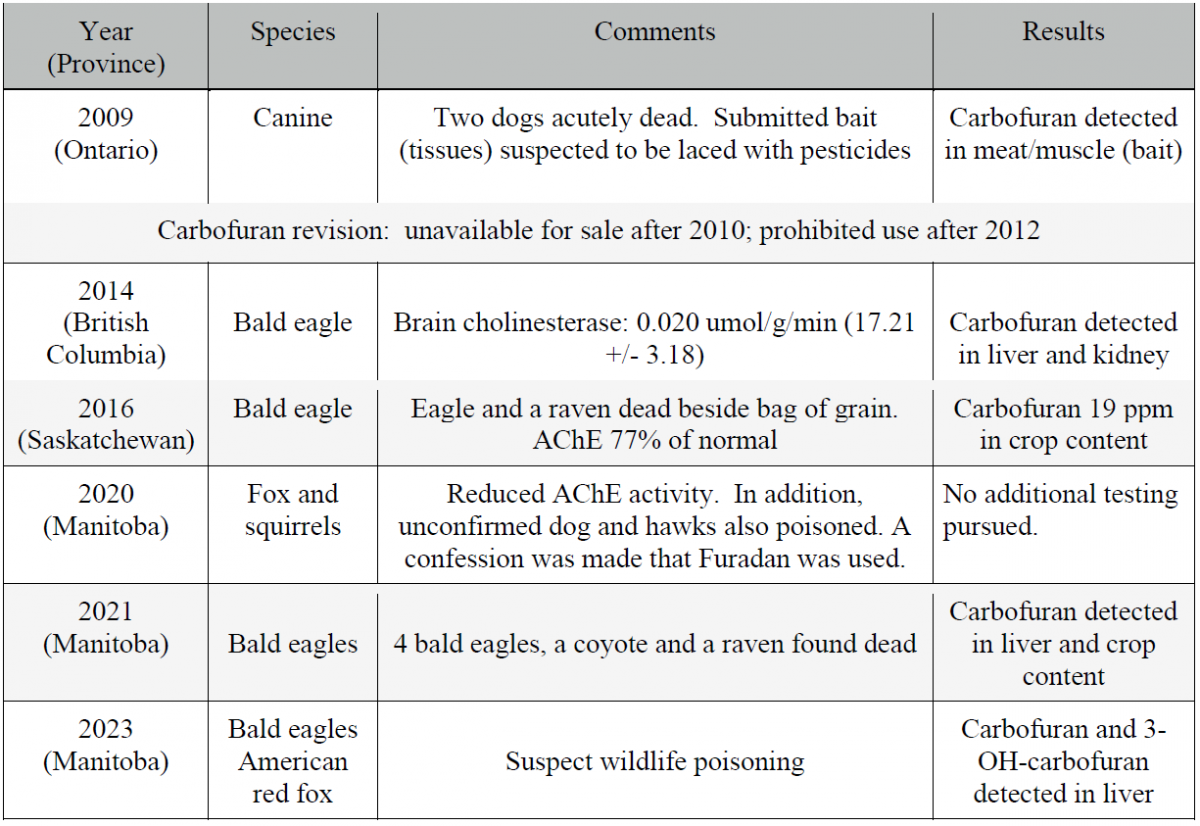Carbamate poisoning in wildlife
Felipe Reggeti, Neil Pople, Nick Schrier
Animal Health Laboratory, University of Guelph, Guelph, ON (Reggeti, Schrier); Veterinary Diagnostic Services, Manitoba Agriculture (Pople)
AHL Newsletter 2024;28(1):30.
Two bald eagles and a red fox were found dead on a farm. The landowner indicated that more dead animals had been found in the same area but did not specify the species or the number of animals. It was suspected that someone had been shooting wildlife from the road or poisoning the animals; therefore, the case was reported to conservation officers who investigated the site and collected the carcasses.
The carcasses were submitted to Veterinary Diagnostic Services, Manitoba Agriculture for diagnostic work-up. Gunshot trauma was ruled out. The fox was scavenged, but there were no other significant findings on postmortem examination. As part of ongoing surveillance, the eagles and fox were tested for highly pathogenic avian influenza virus (HPAI) and were negative. Liver samples were submitted to the toxicology section of the Animal Health Laboratory, University of Guelph for analysis. Carbofuran and 3-hydroxy-carbofuran were detected by LC-MS/MS, confirming exposure.
Carbofuran (trade name Furadan) is a systemic carbamate pesticide for the control of insects (direct contact and/or ingestion) on fruits and vegetable crops. It is highly toxic to humans and animals via oral exposure (LD50: 5 mg/kg rat; 2 mg/kg mice; 0.48 to 0.51 mg/kg in mallard ducks) and inhalation, and it is also absorbed through the skin. Its mechanism of action consists of (reversible) inhibition of cholinesterase enzymes (e.g., acetyl cholinesterase - AChE), leading to continued stimulation of muscarinic, nicotinic and CNS cholinergic synapses. As such, it is a neurotoxin, and exposure of humans and animals may cause clinical signs consisting of salivation, lacrimation, urination, defecation, other gastrointestinal symptoms, and emesis (SLUDGE syndrome); as well as tremors, stiffness, ataxia, dyspnea, seizures, coma, and death in severe cases. 3-OH-carbofuran is a metabolite of carbofuran in plants, insects, and mammals, and it is a known environmental transformation product of carbofuran and carbosulfan. Both the parent molecule and the metabolite are inhibitors of AChE.
Carbofuran products used to be registered in Canada for canola, mustard, sunflower, corn (sweet, field and silage), sugar beet, green pepper, potato, raspberry and strawberry crops; however, a re-evaluation by the Health Canada’s Pest Management Regulatory Agency (PMRA) concluded that carbofuran products posed an unacceptable risk to humans and the environment, and did not meet Health Canada’s standards for human health and environmental protection (RVD2010-16). As a consequence, carbofuran products could not be sold in Canada after 2010, and their application was prohibited after 2012. Despite the regulatory actions, these products have not been completely disposed of and animal poisoning, particularly in wildlife, is still identified (Table 1). AHL
Table 1. Historical cases of carbofuran toxicosis confirmed at the AHL (2009 - 2023).

References
1. Meerdink GL. Anticholinesterase insecticides. In: Clinical Veterinary Toxicology, Plumlee KH, ed. Mosby, 2004;178-180.




